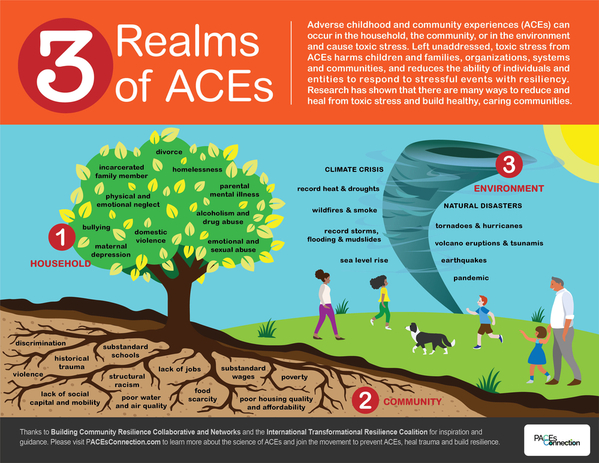Mary Ann Hanson grew up in Fortuna, a former lumber town situated on the Eel River in Humboldt County and a gateway to centuries-old redwoods into the Humboldt Redwoods State Park. Humboldt is also one of the two California counties with the highest percentage of residents whose ACE score is 4 or more.
Hanson herself has an ACE score of 8. Given her roots in Humboldt, a mostly rural county with a population under 150,000, and the difficulties she faced growing up in a family with substance abuse and mental illness, it’s no surprise she is more than motivated to become a champion of educating people about the science of positive and adverse childhood experiences.
Since 2016, Hanson has served as executive director of First Five Humboldt, which provides children and family services throughout the county. The state-created although independently operated agency is funded by the state’s tobacco tax. Hanson also teaches a class on advocacy and child development at Humboldt State University, where she formerly held a position as an instructor in the Child Development Department.
At the state level, Hanson serves on the Primary Care Task Force of the State Surgeon General, Dr. Nadine Burke-Harris. She also chairs the Network of Care Subcommittee, which produced the Network of Care Roadmap for ACEs Aware, a first-in-the-nation, statewide effort to screen for ACEs and to treat the impact of toxic stress.
First Five Humboldt works with the county’s board of supervisors to provide grants to community organizations that are working to reduce ACEs. Humboldt County added ACEs to its legislative platform in 2016 and made trauma-informed care one of the top three strategic goals for various departments, including the sheriff’s department. Five Five Humboldt also launched an ACEs speakers bureau, which offers training on PACEs science and trauma-informed care to any organization that requests this service.
“We’ve trained and partnered with Eureka city schools and smaller school districts as well as the Northern California Indian Development Council, many clinics, and city police and probation departments,” says Hanson.
ACEs training covers more than the original ten ACEs identified in the original CDC-Kaiser Permanente Adverse Childhood Experiences Study. It extends ACEs to include other areas: historical trauma, which is “very relevant to issues in Humboldt County given the genocide of our native people and the boarding school movement here; the pandemic; and climate change. “All three cause toxic stress in families,” Hanson points out.
Humboldt is primarily a rural county with areas, such as south Eureka, the Hoopah reservation, and communities along the Klamath Rivers, where poverty is concentrated. The Hoopah are the second-most populous Native American tribe in California and the second largest employer in the county. They have been severely affected by wildfires and smoke this summer as well as the pandemic and their past history.
Since the COVID lockdown in March 2020, “Training services have been pretty easy to continue to offer [online],” says Hansen. However, to provide home visiting services to families, First Five staff dropped off school materials and food at home and set up one-on-one meetings. They also transferred children’s play groups online.
Right now, COVID vaccination rates are “lower than we would like, and ICUs are full,” she says, although First Five has been actively promoting vaccinations through its social media.
The introduction of trauma-informed education in the county has made a big difference, primarily “in the conversations, the attitudes in the community,” says Hansen. “A core group of pediatricians are now talking about ACEs and how to connect families to social services and a new organization started to engage their entire community to make it trauma informed. The Hoopa just held its ACEs Aware Trauma Conference with all their tribal department heads, a lovely demonstration of infusing trauma-informed principles throughout their valley.”
The ACEs organizer and activist received her B.S. in human development at University of California Davis, where her interest in resilience and toxic stress was reinforced by her mentor, Dr. Emmy Werner, “the grandmother of resiliency research,” says Hanson. Werner conducted a famous 40-year study of 700 babies who were at high risk and found that the difference between those who were happy and those who were not was one caring adult. Her research results have since been supported. Werner also coined and promoted the term resiliency.
Hanson, the mother of three grown children, first learned about the ACE Study in 2015 at a conference featuring a talk by Burke Harris.
“I had been teaching about resilience and stress but had never encountered the ACE Study, she recalls. “It was a lightning-bolt moment that completed the equation—the full picture of toxic stress—for me.” And soon after, she had the good fortune to move into a job that would enable her to champion PACEs education throughout her county and the state.



Comments (1)